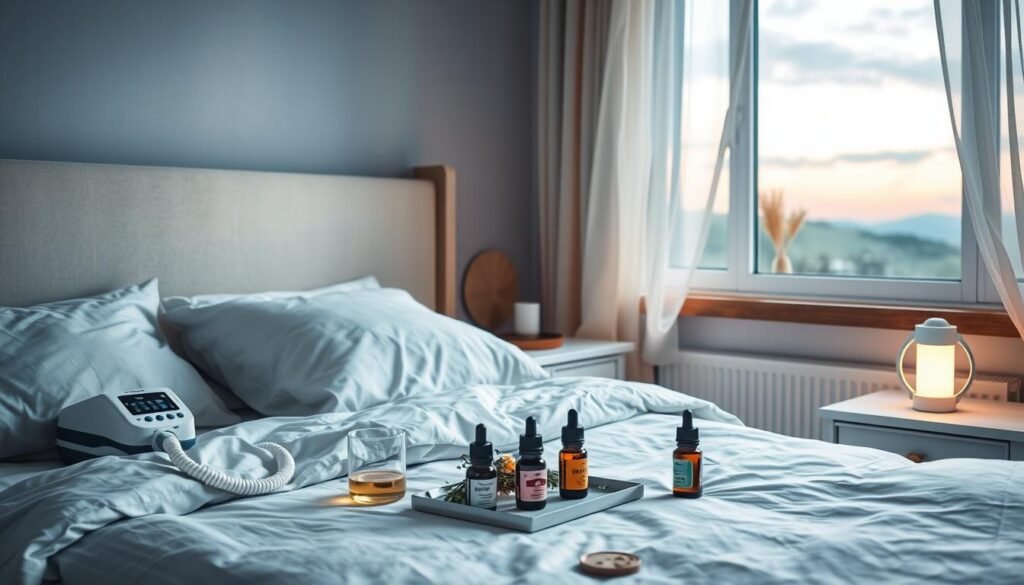Did you know 18% to 42% of people with sleep disorders also have insomnia and sleep apnea? This high number shows how these two problems are connected. They both seriously affect how well you sleep and your overall health. Sleep apnea means you stop breathing for short times while sleeping. Insomnia is when you can’t sleep well. Knowing how they affect each other is key to better treatments and improving lives.
More people are learning about obstructive sleep apnea (OSA), seen in 10% to 20% of adults. Doctors are getting better at spotting and treating these sleep issues. It’s important for everyone to understand how sleep apnea and insomnia work together. They can lead to feeling very tired and having trouble thinking clearly.
Find out more about sleep problems by visiting this resource.
Key Takeaways
- The prevalence of comorbid insomnia and sleep apnea ranges from 18% to 42% among individuals with sleep disorders.
- Among those seeking treatment, the rates of COMISA can be as high as 67%.
- Obstructive sleep apnea is prevalent in about 10% to 20% of middle to older-aged adults.
- Distinct symptom clusters related to insomnia are observed in patients with moderate to severe OSA.
- Innovative treatment approaches combining CBT-I and PAP therapy show positive outcomes for managing COMISA.
- Patient-centered care strategies have proven effective in enhancing clinical management for COMISA.
Understanding Sleep Apnea
Sleep apnea is a sleep disorder that causes frequent breaks in breathing at night. It can lead to serious health problems, especially with insomnia. Knowing about its types and signs is key for proper management and treatment.
What is Sleep Apnea?
Sleep apnea involves conditions that disturb sleep by interrupting breathing. Two main types exist: obstructive sleep apnea (OSA) and central sleep apnea (CSA). OSA happens when throat muscles relax too much, blocking air. CSA is when the brain doesn’t send the right signals for breathing.
Types of Sleep Apnea
- Obstructive Sleep Apnea (OSA): The most common type, which occurs when the throat muscles block airflow.
- Central Sleep Apnea (CSA): This happens due to the brain not signaling the body to breathe, often linked to other medical issues.
- Mixed Sleep Apnea (MSA): Shows characteristics of both OSA and CSA.
Symptoms and Causes
Common signs of sleep apnea include:
- Loud snoring
- Stopped breathing spells during sleep
- Gasping for air in sleep
- Feeling very tired during the day
- Getting irritable and having trouble focusing
Risk factors for sleep apnea vary, and they include:
- Being overweight
- Having a large neck
- Small airways
- A family history of the condition
- Smoking and drinking alcohol
Studies show a strong link between obstructive sleep apnea and insomnia. Those with sleep apnea often have insomnia 40-60% more than others. Experts stress the need for thorough diagnoses because of this link.
For more information about how these conditions interact, see this resource.
Exploring Insomnia as a Sleep Disorder
Insomnia is a common but often misunderstood condition. It shows up as having a hard time either falling or staying asleep. This leads to sleep difficulties and significant sleep deprivation. About one in three adults in the United States deal with chronic insomnia.
Definition of Insomnia
Insomnia means not being able to get restful sleep. Those who have it often get nonrestorative sleep, causing many problems in daily life. Insomnia impacts more than just feeling tired; it disrupts thinking, feelings, and life quality.
Common Symptoms of Insomnia
Signs of insomnia include:
- Difficulty falling asleep at night
- Waking up during the night and not being able to fall back asleep
- Waking up too early in the morning
- Feeling tired or sleepy during the day
- Finding it tough to concentrate or remember things
These sleep difficulties can hurt how well someone does day-to-day tasks and interacts with others. It’s important to understand and deal with insomnia. Doing so can improve sleep and health overall.
Sleep Apnea and Its Relationship with Insomnia
Many people deal with both insomnia and sleep apnea at the same time. This issue, called comorbid insomnia and sleep apnea (COMISA), makes treatment complex. By looking at the data, symptoms, and risks of COMISA, we can see its effects on health.
Comorbid Insomnia and Sleep Apnea (COMISA)
Healthcare workers are seeing more cases of COMISA. About 40-50% of those with obstructive sleep apnea syndrome (OSAS) also have serious insomnia symptoms. Also, 29% to 43% of insomnia patients might have sleep apnea, as shown by the apnea-hypopnea index (AHI). These conditions working together can ruin sleep and lower life quality.
Statistics on Co-occurrence
Studies show how often these sleep disorders occur together. Insomnia impacts 33%-50% of adults, and OSAS affects 4% of men and 2% of women. When people seek help for sleep problems, it’s common to find both issues. One analysis found 4.5% of 1,241 patients had both, showing the need for good treatments.
Risk Factors for COMISA
Certain things raise the risk for COMISA. Obesity and being older are big factors. Bad sleep habits, high stress, and irregular sleep schedules also worsen it. Tackling these risks can help in treating patients with both conditions. For insights on symptoms and causes, check out this article.
The Impact of Sleep Apnea on Sleep Quality
Sleep apnea significantly disrupts sleep quality by affecting sleep patterns. It causes repeated breathing interruptions at night. As a result, sleep becomes fragmented, harming overall sleep quality. This problem can affect many areas of daily life.
How Sleep Apnea Affects Sleep Patterns
People with obstructive sleep apnea struggle to stay asleep. This issue is more common in those with the disorder. For men, 52% face this problem, and for women, it’s 62%. The apnea/hypopnea index (AHI) shows the extent of poor rest. It highlights a cycle of sleep disturbance impacting sleep quality.
Many individuals with the condition also find starting sleep difficult. This adds to their sleep issues.
Daytime Consequences of Poor Sleep Quality
The consequences of poor sleep are felt during the day. Those with sleep apnea often feel very tired in the daytime. This tiredness affects their thinking and increases the risk of accidents.
They feel unrefreshed even after long sleep periods. Mood disturbances and a lower quality of life are common. Research shows that people with sleep maintenance issues feel sleepier in the daytime. Their Epworth Sleepiness Scale scores are higher, at 12.2, compared to 10.9 for others without these problems.

| Impact Area | Statistics |
|---|---|
| Men with Sleep Apnea Experiencing Maintenance Issues | 52% |
| Women with Sleep Apnea Experiencing Maintenance Issues | 62% |
| Average Epworth Sleepiness Scale Score (DMS) | 12.2 |
| Average Epworth Sleepiness Scale Score (No DMS) | 10.9 |
| Physical Quality of Life Score (DMS) | 39 |
| Physical Quality of Life Score (No DMS) | 42 |
| Mental Quality of Life Score (DMS) | 36 |
| Mental Quality of Life Score (No DMS) | 41 |
How Insomnia Affects Sleep Apnea Symptoms
Insomnia can worsen sleep apnea symptoms, creating a tough cycle. This connection makes managing both sleep apnea and insomnia critical. It’s important to understand how they affect each other.
The Cycle of Sleep Deprivation and Symptoms
Insomnia leads to less muscle tone in the body’s upper airway. This increases the risk of breathing problems during sleep. Thus, people with sleep apnea may face more breathing interruptions at night.
These interruptions can vary greatly, affecting sleep and causing daytime tiredness. This can harm a person’s daily life, making it hard to function well.
Behavioral Factors Involved
Behavior and lifestyle can influence the connection between insomnia and sleep apnea. Worrying about sleep can make it harder to rest. Moreover, habits like smoking or being overweight can make sleep apnea worse.
Smokers have a higher risk of sleep apnea. Extra weight can also block the airway more. It’s key to tackle these issues to improve sleep and reduce insomnia.
The Clinical Challenges of Diagnosing COMISA
Diagnosing Comorbid Insomnia and Sleep Apnea (COMISA) is hard for doctors. Symptoms of both conditions overlap, making it tricky to identify them correctly. It’s crucial that patients get the right diagnosis to be treated properly.
Misdiagnosis happens a lot. Often, doctors think the problem is just insomnia, missing the sleep apnea. This mistake leads to treatments that don’t work well.
Importance of Accurate Diagnosis
Getting the diagnosis right is very important. Without recognizing sleep apnea, patients miss out on important treatments like CPAP therapy. Not treating both conditions increases health risks significantly.
Proper diagnosis lowers the chance of death by 47% and reduces heart disease by 75%. It makes treatments more effective, helping patients feel better.
Common Misdiagnoses and their Consequences
When misdiagnosis occurs, it’s bad for patients. They might get treatments that don’t help their sleep apnea, making their insomnia worse. This leads to a lot of daytime problems.
People with COMISA are often more depressed and enjoy life less. They are also less likely to follow through with treatments. Doctors need to work together to check for both conditions and diagnose them correctly.
Innovations in Assessing COMISA
New studies shed light on the complex issue of comorbid insomnia and sleep apnea (COMISA). It’s important to have good ways to check for these issues together. This work helps us better understand patients’ unique situations by looking closely at their symptoms.
Recent Research Findings
Latest findings suggest a new way to look at symptoms altogether can improve COMISA assessment. By using at-home sleep tests and detailed behavior evaluations, doctors can learn a lot about someone’s sleep. This leads to better treatment plans. Check out this study for more.
Symptom Profiles and Diagnostic Approaches
Building detailed symptom profiles requires using many different tools. This helps to reflect what the patient is going through accurately. Including the patient’s own views and choices makes care better. Combining insomnia therapy with airway pressure treatment has shown to be effective.
A team approach is key for long-term care. It deals not just with symptoms now but aims to improve overall health later. Finding new ways to assess and treat COMISA is a goal for doctors today.
Treatment Options for Sleep Apnea and Insomnia
There are many ways to treat sleep apnea and insomnia. The best plan depends on the person. It’s important to tackle root causes to improve sleep.
Standard Treatments for Sleep Apnea
CPAP therapy is the top choice for obstructive sleep apnea. It uses air to keep airways open. For those who prefer not using machines, oral devices are an option. Surgery is a last step when other methods don’t work.
- CPAP therapy: Most commonly prescribed for OSA
- BiPAP and APAP machines: Offer customized airflow adjustments
- Oral appliances: Suitable for those who prefer a non-machine option
- Surgical options: Considered when other treatments fail
Cognitive-Behavioral Therapy for Insomnia (CBT-I)
CBT-I is the go-to method for tackling insomnia. It’s shown to work as well as, or better than, meds. This therapy helps change the habits and thoughts that interfere with sleep. While meds might be needed short term, the goal is to overome reliance on them.
Sleep meds can help right away, but they’re not a long-term fix. Using them with CBT-I can lead to better sleep over time.
Treating sleep disorders can make a big difference in someone’s life. It’s key to work with doctors to find a treatment that fits. This might include changes in daily habits, therapy, and needed medications.

Combining Treatment Strategies for COMISA
Treating COMISA involves unique challenges. Doctors must decide if they should treat insomnia and obstructive sleep apnea together or one after the other. Each method has advantages depending on what the patient needs and how they react to treatments.
Simultaneous vs Sequential Treatment Approaches
Researchers have found that starting with CBT-I before CPAP therapy helps patients adjust better and reduces insomnia symptoms. Those who follow this sequential treatment often see better results over time. On the other hand, treating both conditions at the same time might work better for some patients, especially those severely affected by both disorders.
Understanding different treatment strategies can help manage COMISA better. Here are key points to consider:
| Aspect | Sequential Treatment | Simultaneous Treatment |
|---|---|---|
| Patient Comfort | Allows gradual adjustment to treatment, easing anxiety. | Immediate relief for both conditions, reducing overall symptomatic burden. |
| Clinical Evidence | Supported by studies showing positive insomnia outcomes prior to CPAP. | Demonstrated effectiveness in tackling co-occurring disorders at once. |
| Long-term Management | Focus on sustained progress through phased treatment. | Potential for quicker stabilization of patient condition. |
Choosing the right treatment strategy is crucial for patient care in dealing with insomnia and OSA symptoms. Healthcare professionals must tailor treatments to each individual for the best outcome. Knowing all available options helps patients take an active role in their treatment, aiming for better results. Non-drug treatments like CBT-I are worth considering. For more info on insomnia treatment options, check out this resource.
Lifestyle Modifications for Improved Sleep
Making lifestyle changes is key to better sleep. This is true for those with sleep apnea and insomnia. Simple shifts in daily habits can make a huge difference. Good sleep hygiene, along with focus on diet and exercise, boosts sleep quality.
Sleep Hygiene Practices
Good sleep hygiene is vital. Here are some tips:
- Maintain a consistent sleep-wake schedule to regulate the body’s internal clock.
- Create a calming bedtime routine that signals the body it’s time to wind down.
- Ensure a comfortable sleep environment, including a cool, dark, and quiet room.
- Avoid heavy meals, caffeine, and spicy foods close to bedtime to minimize disturbances during the night.
- Limit exposure to screens for at least an hour before sleeping.
Impact of Exercise and Diet on Sleep
Diet and exercise play a big role in sleep quality. Being active boosts oxygen levels and can cut down on sleepiness. This helps you sleep better.
| Factor | Benefits |
|---|---|
| Exercise |
|
| Diet |
|
Adopting these changes can boost sleep quality and lead to a healthier life. These tips can guide you through sleep challenges.

Long-Term Health Implications of COMISA
Comorbid Insomnia and Sleep Apnea (COMISA) can seriously impact long-term health. People with COMISA face a greater risk of heart disease and diabetes. Addressing both insomnia and sleep apnea together is crucial for effective treatment.
Associations with Other Health Conditions
Research shows that COMISA patients have a higher chance of major cardiac events. Out of 181 elderly patients studied, 90 faced such events over 43 months. The risk of unstable angina is also greater due to COMISA, influenced by factors like gender, being under 70, and obesity.
Quality of Life Factors
Life quality drops for those with COMISA because of ongoing fatigue, thinking problems, and social issues. They struggle with severe sleep issues, causing unrest and lower productivity. Combating insomnia and sleep apnea is key to improving lives.
Using Cognitive Behavioral Therapy for Insomnia (CBT-I) and positive airway pressure (PAP) together can help. These methods offer hope for better health and well-being.
COMISA deeply affects patients’ health and daily life. For more on COMISA and its ties to serious health issues, visit this study.
Conclusion
It’s crucial to understand how sleep apnea and insomnia affect each other. This knowledge helps in creating better treatments for patients. These sleep disorders, also known as COMISA, require detailed checks and diagnosis. By knowing the high rates of these conditions, doctors can plan better care.
Treating both sleep apnea and insomnia is vital. Research shows that people with severe sleep problems have a higher risk of dying early. They also may feel more depressed. Treating these conditions improves sleep and mood.
Keeping up with the latest research is important for patient care. Understanding sleep apnea and insomnia helps doctors give personalized treatment. This can make sleep better and improve health, offering hope to those in need.